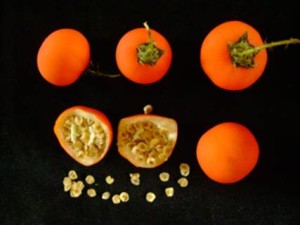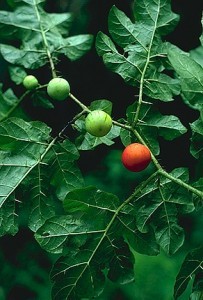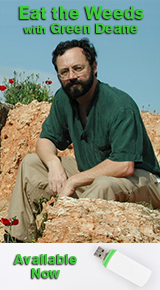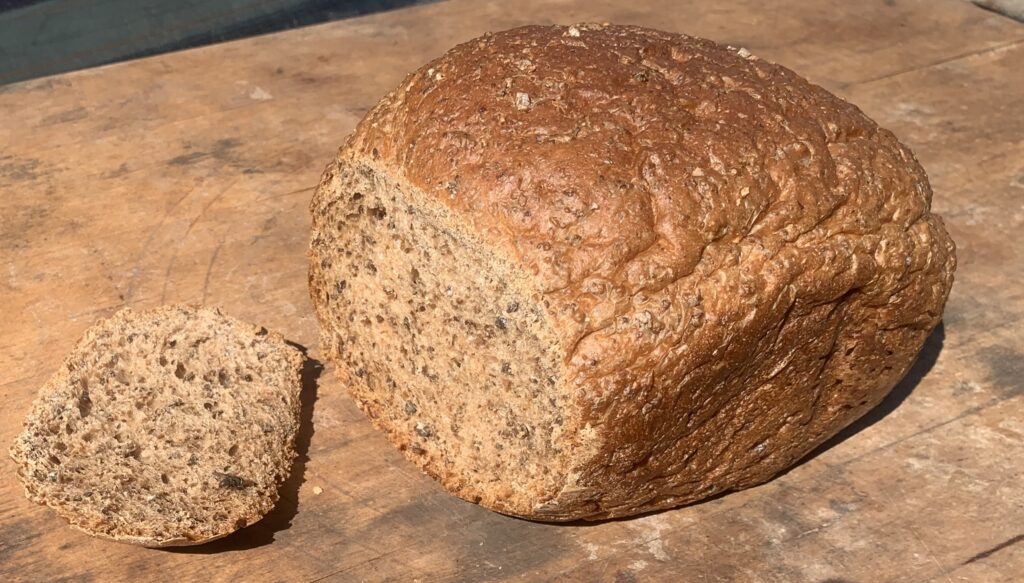
Acorn bread, tasty but a lot of work. Photo by Green Deane
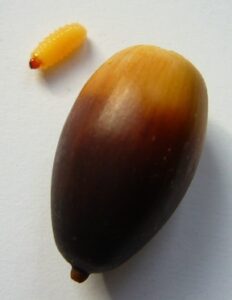
Acorn grubs are edible. Photo by Green Deane
Can you make bread out of acorns? Yes, is it tasty? yes. Calorie positive? Can be, it’s a lot of work. The acorns have to be collected, shelled, ground, soaked in multiple changes of water, dried, then baked. It’s a bread that, suitably, takes a stable village to make, though you can do it all by yourself. Depending upon the time of year many acorns might have a yellowish red-tipped grub inside. Put the acorns in a container over night, the larvae usually crawl out and collect at the bottom. They are edible fried and are very buttery. But before cooking the larvae, break each one or they will explode when heated. (Each is a sealed container of moisture.) I have been told by an entomologist that any bug you find in an acorn will be edible. Some weevils lay eggs in acorns, some drill a small hole, others look for cracked acorns to lay eggs in. Throw away any moldy (green)acorns kernels.
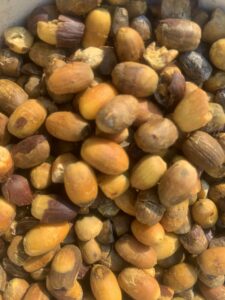
Shelled unsoaked acorns. Photo by Green Deane
The loaf of bread above used one cup of white acorn meal, one cup of regular flour, and two tablespoons of gluten (because acorn flour when baked is crumbly like cake.) Two tablespoon of sugar, three tablespoons of honey, a teaspoon of salt and half a teaspoon of yeast and 175mm of water. Acorn bannock usually does not use flour or yeast but is pan or open-fire cooked and risen with baking powder.
Commercially processed acorn flour cost about $25 a pound, and has no gluten. Without gluten the texture of baked acorn goods have the crumble of cake, adding gluten gives a bread-like texture. Acorn selection: It take about the same time and energy to process large acorns as it does small one. For your labor larger acorns produce more flour. Also the color of the acorn “nut” is important. The more orange it is the more tannins and leeching required. The lighter yellow it is the less tannins, and the sweeter the flour will be. If an acorn has sprouted, the sprout is edible.
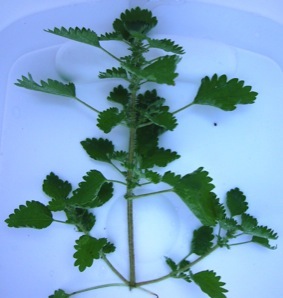
The entire plant is covered with stingers. Photo by Green Deane
Light dustings of frost this past week suggested a closer look for one of our winter edibles, stinging nettles. We found some at Eagle Lake Park in Largo. Our heart-leaf nettle (Urtica chamaedryoides) has perhaps the worse sting of any nettles in North America. Its sting give me bloody welts. My favorite way to consume this nettle is dry the plant next to a fire which often makes them taste like crispy kale. While our stinging nettle is not the same species as its well-known relative, Urtica dioica, it is used the same way and has a similar nutritional profile. The species is usually common by January and gone by March. It tops out at a little more than a foot tall and as mentioned has a terrible sting (which is found only on parts above ground, so handling them by their roots is good practice.)
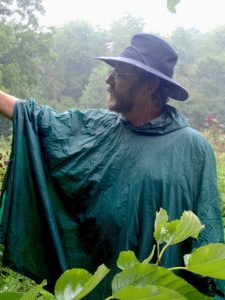
Classes are held rain or shine or cold. (Hurricanes are an exception.) Photo by Kelly Fagan.
Foraging classes, now that the rash of storms has past, it is time to resume regular classes.
Dec 14th Wickham Park: 2500 Parkway Drive, Melbourne, FL 32935-2335. Meet at the “dog park” inside the park (turn right after entrance, go 1/4 mile, dog run on right, parking at run or on previous left.) 9 a.m. to noon.
Dec 15th Mead Garden: 1500 S. Denning Dr., Winter Park, FL 32789. Meet at the bathrooms. 9 a.m. to noon.
Dec 20th Winter Park: My 11th annual Urban Crawl. See below.
Dec 21st Eagle Lake Park: 1800 Keene Road, Largo, FL 33771. Meet at the pavilion near the dog park. 9 a.m. to noon.
For more information on these classes, to prepay or sign up go here. The cost is $30 per adult (the class is usually three hours long and examines five-dozen or so species.) If cost is a hardship email me at: GreenDeane@gmail.com. Don’t forget Dec.20th is my 11th annual Urban Crawl. It’s a free class in downtown Winter Park, starts at 10 a.m. in front of Panera’s, 329 N Park Avenue in Winter Park, FL.
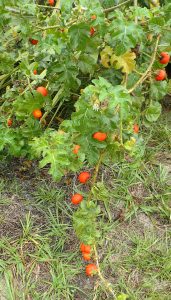
Tropical Soda Apple. Photo by Green Deane
No. It is not edible. No. It is not medicinal. Well… maybe it is medicinal, and if anyone says it is edible I ain’t going to try it.
Locally you can see two different “Horse Nettles” this time of year, neither are proven edible as far as I know. One has red fruit, the other yellow (and that can vary, too.) The latter is Solanum Carolinense and that is definitely off limits. Toxic. The former, Solanum ciliatum is more iffy. It’s also called a Cockroach Berry Soda Apple or the Tropical Soda Apple though that is usually a different species, S. viarum.)
The first problem is S. ciliatum is not native. How it got to the United States is a good guess. Some think the seeds arrived in the intestinal track of cattle from South America. The second problem is some members of this family grow more toxic as they age while others grow less toxic. There are reports of S. ciliatum being used medicinally for things like rheumatism, arthritis, and skin diseases. It does contain steroidal alkaloids. It has also poisoned cattle and sheep (which makes one wonder if it is that toxic to cattle why do they think it was imported in the dung of cattle? However, it might be that leaves and fruit have different toxicities. The poisoning could have come from leaves or green fruit while the ripe fruit seeds were just non-digested hitchhikers.) The third problem is the plant itself has had well over a dozen botanical names, close to a dozen and a half actually. That makes it difficult to know what plant is actually being discussed and if the traits attributed to it are really about that plant.
The worse problem is that about a decade ago I found an American university publication that listed the species (S. ciliatum) as edible. Do not try to eat it because that is just too iffy for a plant that is also widely reported as highly toxic and fatal, especially the green fruit. I suspect the university botany department was just as confused regarding the identification of the plant as are others. What I wonder about is the ripe fruit. I’ve never seen any credible reference with the necessary details. What I would like to know is what if anything did Brazilian natives do with the plant? That could be a credible reference. Perhaps some of our Portuguese speakers can find that out. Indeed, on one Brazilian site it says (if the translation is to be trusted) “every child ate that fruit” and “consumption can only eat the skin with a thin layer of meat. The seeds are bitter and are not intended for consumption. The rind of the fruit can also be used in cooking, using it just like chili.” But… is it the same species? I am not going to try.
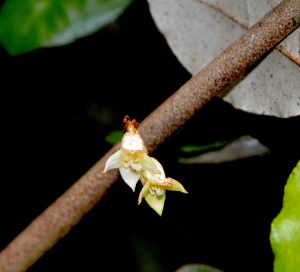
Silverthorn blossoms are boxy. Photo by Green Deae
Foragers benefit from bad ideas. One of those is taking plants from one place on earth to another. We harvest and eat a lot of local plants that came from somewhere else. One of them is so far from home that it fruits in February.
The Silverthorn is native to Southeast Asia. It came to North America as an ornamental about 200 years ago. Early botanists were sure it would not become an invasive pest because they said the fruit were not nutritious for birds. Thus the birds would not eat them and spread the seeds around. The problem is no one told the birds that (and if birds did not spread the seeds around in Asia, what did?) In some areas the Silverthorn is an invasive species and forbidden. In other areas it is still sold as an ornamental. We call it tasty.
While the Silverthorn fruits around early February now is the time to be looking for the shrub and blossoms. The bush hides the blossoms and they are a bit strange looking, if not futuristic. The four-petaled speckled blossom turns into a red jelly bean-like fruit with gold and silver speckles. They are bitter and sour until ripe. The shelled seed is also edible. Altogether the fruit is high in vitamin C, lycopene, and Omega 3 fatty acids. And that is a tasty treat in the middle of winter. To read more about the Silverthorn go here.
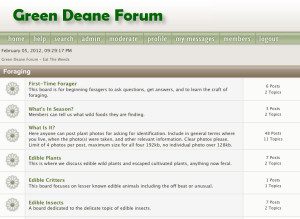
Green Deane Forum
Tired of Facebook and want to identify a plant? The Green Dean Forum is up and running again. Have you come to dislike Facebook, then join us on the forum. Perhaps you’re looking for a foraging reference? You might have a UFO, an Unidentified Flowering Object, you want identified. On the Green Deane Forum we — including Green Deane and others from around the world — chat about foraging all year. And it’s not just about warm-weather plants or just North American flora. Many nations share common weeds so there’s a lot to talk. There’s also more than weeds. The reference section has information for foraging around the world. There are also articles on food preservation, and forgotten skills from

You get the USB, not the key.
172-video USB would be a good end of spring present and is now $99. My nine-DVD set of 135 videos has been phased out. The USB videos are the same videos I have on You Tube. Some people like to have their own copy. Most of the 172 USB videos have to be copied to your computer to play. If you want to order the USB go to the DVD/USB order button on the top right of this page. That will take you to an order form.
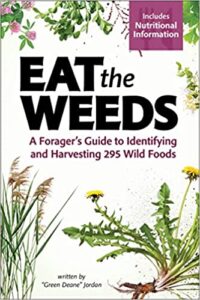
Now in second printing.
EAT THE WEEDS, the book, 274 plants, 367 pages, index, nutrition charts and color photos. It’s available in many locations including bookstores, Amazon. Most of the entries include a nutritional profile. It can also be ordered through AdventureKeen Publishing.
This is weekly newsletter #616. If you want to subscribe to this free newsletter you can find the sign-up form in the menu at the top of the page.
To donate to the Green Deane Newsletter click here.

